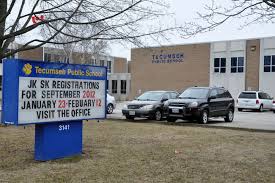 By Walter Byj
By Walter Byj
May 1, 2015
BURLINGTON, ON
While some parts of the Halton region are experiencing high growth spurts, others have remained stable. In one part of the Region, schools need to be built to accommodate the growing population while others areas face shrinking school populations. This is the case for a number of areas in established geographical areas of Burlington.
For elementary schools, Burlington has 10 areas that are identified by an ERA -Elementary Review Area – (remember the acronym – it gets used frequently) number and capacity is measured by OTG – on the ground – (same with this one) seats that do not include portables. Each of these areas has their unique situations.
ERA 100 (Aldershot and Tyandaga) is in western Burlington and is represented by Aldershot Elementary, Glenview King’s Road and Maplehurst, the utilization of the totality of the schools is in the 63% to 68% range and will remain so for the next 10 years. Aldershot Elementary is currently at 46% and will continue at that rate for the next 10 years while King’s Road will decline from 66% in 2014 to 52% by 2024.Maplehurst is currently at 71% while Glenview stands at 93% for the current year.
 The enrolment should be somewhat consistent for the next 10 years with a potential uptick for Glenview pending the development of the northern Aldershot community north of the QEW.
The enrolment should be somewhat consistent for the next 10 years with a potential uptick for Glenview pending the development of the northern Aldershot community north of the QEW.

Central High School enrollment is expected to increase
ERA 101(Downtown) covers the downtown core of Burlington and includes Burlington Central, Central Lakeshore and Tom Thomson schools The overall utilization rate is currently 91% and should remain in that area for the next 10 years. The number is highly influenced by Tom Thomson which in reality is overcapacity as it has 10 portables (mainly due to French Immersion) and will continue their use for the next 10 years. Burlington Central is at 65% currently and is projected to increase to 73% by 2024. Central is at 84% and projected to fall to 72% by 2024. Lakeshore should grow from its current 63% to 73% in 2024.

Tecumseh is in an area where several schools have gone beyond their built capacity.
ERA 102 (Roseland and Shoreacres) is bound by Guelph Line to the west, Appleby to the east with the QEW to the north and the lake to the south. It includes John Tuck, Pauline Johnson, Ryerson and Tecumseh. This area has a utilization rate of 88% which will drop to 77% in the following 10 years. Both Tuck (134%) and Pauline Johnson (117%) are over overcapacity and currently rely on portables to accommodate students. By 2024, Tuck is projected at 107% and Pauline Johnson at 110%. Ryerson currently is at 49% and is expected to grow to 53% by 2024. Much of this growth will come from phasing in the gifted program from Charles R. Beaudoin. Tecumseh will drop from the current 57% capacity to 51% by 2024.
It should be noted that there are no French immersion classes in this area as the students attend either Tom Thomson or Pineland.

Enrollment at Mohawk is expected to decline going forward.
ERA 103 (Appleby) covers the area between Appleby line and Burloak with the QEW to the north and the lake at the south. There are three schools in this area, Frontenac, Mohawk Gardens and Pineland and has an overall utilization rate of 78% which will remain steady to 2024. Mohawk has a rate of 71% but this is expected to drop to 63% by 2024. Frontenac, at 56% is expected to grow to 76% by 2024. This will mainly be due to Pineland becoming a French Immersion school with the English stream moving in some part to Frontenac or Mohawk. Pineland, at 111% is well over capacity and has six portable to cover the overflow. As the transition to a French Immersion school only continues, the utilization rate will slowly decrease to 88% by 2024.
ERA 104 & 105 (Brant Hills, Headon and Tyandaga) is bounded by Dundas to the north and Upper Middle to the south with Walker’s Line being the eastern boundary. The four schools in this area are Brant Hills, Bruce T. Lindley, CH Norton and Paul A. Fisher and have a current utilization rate of 87% which will decline to 76% by 2024. Brant Hills has the lowest utilization rate at 59% and is projected to drop to 57% in 2024. Bruce T. Lindley is healthy at 93% and will remain stable for the next 10 years and is projected to be 89% in 2024. C.H. Norton is healthy at 91% but will slide to 73% in 2024, while Paul A. Fisher is currently at and will remain in the low 60 percentile for the next 10 years.
ERA 106 (Mountainview and Palmer) holds four schools with highway 407 on the west, Walkers on the east with Upper Middle on the north and the QEW to the south. The utilization rate for this area is 87% and should fall to 76% by 2024. Although each school currently has a strong utilization number, they will each experience decreasing numbers in the upcoming years as follows;
Clarksdale – 94% to 77% (2024)
Dr. Charles Best – 92% to 84% (2024)
Rolling Meadows – 78% to 68% (2024)
Sir E. Macmillan – 96% to 77% (2024)
ERA 107 (Millcroft) has two schools, (Charles R. Beaudoin and Florence Meares) and is between Walkers Line and Appleby and Dundas to the north and the QEW to the south. This area is currently at 105%, but is expected to drop to 86% by 2024. Charle R. Deaudoin will drop from its current 114% to 80% in 2024 while Florence Meares will drop from 95% to 91% during the same time period.
ERA 108 (Orchard) contains three schools (Alexander’s, John William Boich and Orchard Park) and lies between Appleby and Bronte and Dundas to the north and the QEW to the south. This area is currently at 115% of OTG and will slowly decline to 93% by 2024. Both J.W. Boich and Orchard Park are over utilized and will continue until 2024. Alexanders, which is currently at 119% is expected to drop to 70% by 2024.

The public school in Alton is already beyond capacity; Hayden High School is now operating with all the high school grades.
ERA 109 (Alton) has one school, Alton Village, and is bound by the 407 to the north, Dundas to the south and Walkers to the west and Tremaine to the east. This school is over utilized at 124% and this could rise to 153% by 2024.
ERA 110 (Rural Burlington) has one school also, Kilbride, and has a current OTG of 77% which will drop to 73% by 2024.
These numbers reflect a bleak future for some of the elementary schools in Burlington. Forecasting is not an exact science, but unless Burlington has a major change in its population makeup Burlington might be looking at some consolidation.















Seems easy to me. Move everyone west of Pomona over to Lakeshore – Then we can find out if the Fraser Institute ratings at Tuck are based on a superior education experience or demographics?